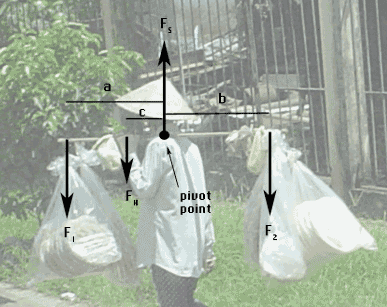 |
This is a very common sight in Vietnam. The women
sometimes carry very heavy bundles by fastening them to the ends of a
pole balanced on her shoulder. This particular woman is seen in Ho Chi
Minh City. We can use the concept of torque to examine the system.
|
|
What forces are at work?
Shown at the right is a free-body diagram showing the forces on the pole.
Fs is the force of the woman's should
supporting the pole, F1 and F2
are the forces of the bundles' weight at each end of the pole,
and FH is the force of the hand on the
poll. FH could be positive or negative
or zero, depending on whether her hand is pulling down on the poll, pressing
up, or doing neither.
How does the system balance?
Intuitively, we know that she can balance the pole at its central point
if F1 = F2
and FH is zero.
But what happens if F1 is not
equal to F2?
|
 |
Any force applied at some distance from the pivot point tries to rotate the
pole; that is, it applies a torque. F1 and FH
try to rotate the poll in the positive (counterclockwise) direction, while F2
tries rotate the poll in the negative (clockwise) direction. The torque applied
is equal to the force times distance from the pivot point. In this case, the
sum of the torques on the system can be found:
∑Torques = aF1 + cFH
- bF2
In this case, the sum of the torques should be zero because we
do not want to pole to rotate. So, if aF1 =
bF2, then she does not need to apply any force
with her hand. However, if F1 < F2,
then she can either increase a and decrease b, or she can apply downward force
with her hand, as shown in the picture.
© 2004 Ana Marx

